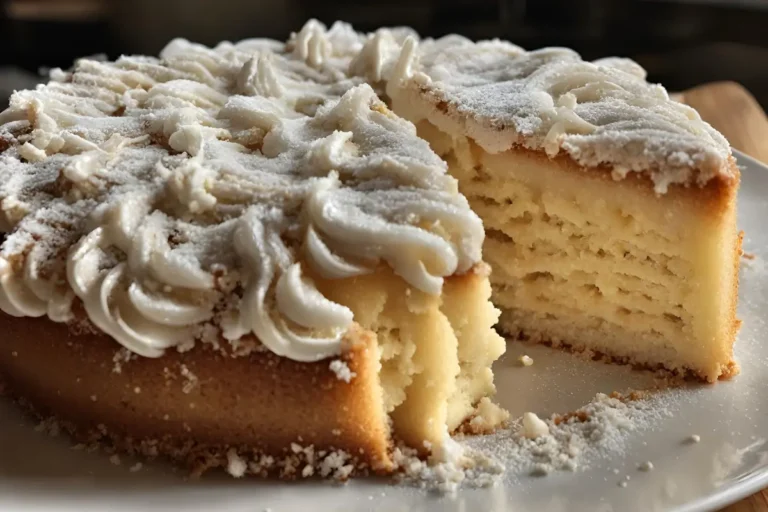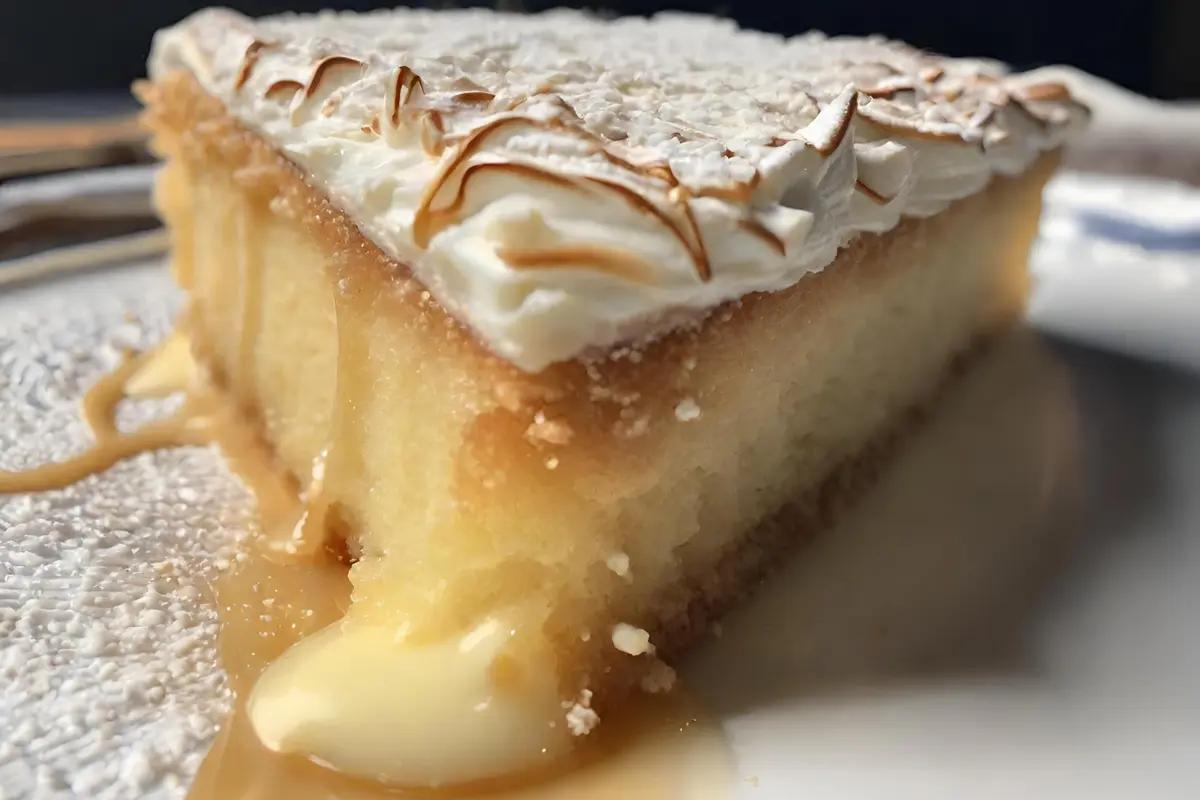Introduction to Butter Cake: A Sweet Start
Are you ready to learn how to cook butter cake? Whether you’re a beginner eager to bake your first cake or a seasoned baker refining your skills, this guide will take you through the essential steps for crafting a classic butter cake that’s rich, fluffy, and delightfully buttery. From selecting the right ingredients to the finishing decorative touches, we’ll cover all you need to know to bake the perfect butter cake. Dive into the delicious and comforting world of butter cakes with us!
Introduction to Cook Butter Cake
What is Butter Cake?
Butter cake, a staple in the world of desserts, is celebrated for its rich, buttery flavor and soft, tender crumb. Originating from the traditional pound cake, which balances a pound each of butter, sugar, eggs, and flour, today’s butter cake recipes have evolved, offering a lighter texture but retaining that all-important buttery essence.
The Popularity of Butter Cake
It’s no mystery why butter cake is a favorite at gatherings and a classic choice for afternoon teas. Its simple elegance and satisfying taste make it a beloved choice across generations and cultures. With its golden crust and soft, moist interior, a well-made butter cake is a testament to the beauty of baking simplicity.
A Brief History of Butter Cake
Tracing its roots back to Europe, the butter cake has undergone numerous transformations before becoming the version we love today. Initially more of a dense bread, bakers began to add leavening agents like baking powder, which gave rise to a lighter, more delicate cake. Over time, variations have emerged globally, each adding a local twist to the traditional recipe.
Stay tuned as we delve deeper into the essential ingredients that make up this delightful cake in the next section. We’ll cover everything from choosing the right type of butter to the role of each component in creating the perfect butter cake.
Essential Ingredients and Tools
Selecting Your Ingredients
Choosing the right ingredients is crucial for a perfect butter cake. The star of the show is, of course, unsalted butter, which provides the cake’s foundational flavor and rich texture. For the best results, ensure the butter is at room temperature to blend smoothly with sugar.
- Flour: Opt for all-purpose flour for its reliable structure. If you aim for an even softer crumb, a mix of cake flour can be introduced.
- Sugar: Granulated sugar is typical, lending sweetness and aiding in the creaming process that introduces air into the batter.
- Eggs: Room-temperature eggs are essential as they emulsify better into the batter, contributing to the cake’s moisture and structure.
- Leavening agents: A touch of baking powder gives the cake its rise, making it fluffy rather than dense.
Essential Baking Tools
Equally important to the ingredients are the tools you use. Here’s what you’ll need:
- Mixer: A stand mixer or an electric hand mixer will make the creaming process a breeze.
- Cake pans: The right pan matters. A standard round pan is most commonly used, but a bundt pan can add a decorative flair.
- Mixing bowls, measuring cups, and spoons: Accuracy is key in baking, so ensure you have these basics at hand.
Using these tools and ingredients, you’re set up for success. Now, let’s move on to how you can combine these elements to bake your butter cake to perfection. Up next, we dive into the step-by-step baking process, where precision meets passion in the art of cake making.
Step-by-Step Baking Process
Preparing Your Baking Station
Before you start, it’s important to get everything in place. Begin by preheating your oven to the right temperature—usually around 325°F (165°C) for a butter cake. Grease your cake pan with a little butter and dust it with flour to ensure your cake comes out cleanly.
- Mixing Dry Ingredients: In one bowl, whisk together your flour, baking powder, and a pinch of salt. This ensures these dry ingredients are evenly distributed.
- Creaming Butter and Sugar: In another bowl, beat the butter and sugar together until the mixture is pale and fluffy. This process is crucial as it incorporates air into your batter, making the cake light.
Combining Wet and Dry Ingredients
- Adding Eggs: One at a time, mix in the eggs to the creamed butter and sugar, ensuring each is fully incorporated before adding the next.
- Alternating Dry and Wet Ingredients: Start by adding about a third of your dry ingredients to the butter mixture, followed by half of your wet ingredients (like milk or buttermilk). Repeat this step until all ingredients are just combined; overmixing can lead to a tough cake.
Baking the Cake
Using a spatula to smooth the top, pour the batter into the cake pan that has been prepared. To pop any large air bubbles, lightly tap the pan against the counter. A toothpick put into the center of the cake should come out clean after baking in the preheated oven until the cake is brown. Depending on your oven’s specifications and the size of your cake pan, this normally takes 60 to 75 minutes.
Cool the cake in the pan for about 10 minutes before transferring it to a wire rack to cool completely. This step is essential as it prevents the cake from becoming soggy.
With your cake baked and cooling, you’re almost ready to move on to the final touches. Next up, we’ll explore how to add those beautiful finishing touches with decoration and proper serving techniques for your butter cake.
Decorating and Serving
Creative Decoration Ideas
Once your butter cake has cooled, it’s time to get creative with the decorations. A simple dusting of powdered sugar can enhance the elegance of your cake. For those who like a bit more flair, here are a few ideas:
- Buttercream Frosting: Whipping up a batch of buttercream frosting using unsalted butter, powdered sugar, and a splash of vanilla can create a smooth, spreadable frosting perfect for a classic look.
- Fresh Fruit Toppings: Adding slices of fresh strawberries or a handful of blueberries can introduce a fresh, colorful contrast to the rich buttery yellow of the cake.
Perfect Serving Techniques
Serving your cake beautifully is just as important as how it tastes. Here’s how to do it right:
- Slicing: Use a long, sharp serrated knife to slice your cake. This ensures clean cuts without crumbling the tender crumb of your butter cake.
- Presentation: Serve each slice on a pretty plate with a dollop of whipped cream or a drizzle of caramel sauce for an extra touch of sweetness.
These tips will not only make your cake visually appealing but also enhance the overall eating experience, making each bite a delight.
Tips for the Best Presentation
Remember, the first impression is crucial. Arrange your cake on a serving platter and if you’re using decorations like edible flowers or themed cake toppers, place them thoughtfully. Each element should add to the cake’s beauty without overwhelming it.
With your cake beautifully decorated and ready to serve, you’re all set to impress at any gathering. In the next section, we’ll cover how to store any leftovers to keep your cake as fresh as possible. Stay tuned!
Storage Tips
Storing the Cake at Room Temperature
Butter cake can be deliciously moist and fresh if stored correctly. If you’re planning to eat the cake within a couple of days, storing it at room temperature is perfectly fine. Simply cover it with a cake dome or invert a bowl over it to protect it from dust and to keep it moist.
- Avoiding Humidity: Keep the cake in a cool, dry place away from direct sunlight, which can melt any frosting and affect the texture of the cake.
Freezing for Long-Term Storage
For longer storage, freezing your butter cake is an effective method. Here’s how to do it right:
- Wrapping Properly: Double-wrap your cake in plastic wrap, followed by a layer of aluminum foil to protect it from freezer burn and odor absorption.
- Thawing: When you’re ready to enjoy your cake, thaw it overnight in the refrigerator and then bring it to room temperature before serving. This helps maintain the moisture and texture.
Tips for Maintaining Freshness
- Slice Before Freezing: If you prefer, you can slice the cake before freezing. Wrap each slice individually for easy single servings. This way, you can enjoy a piece of cake anytime without having to thaw the entire cake.
These storage tips will help you keep your butter cake tasting fresh and delicious, whether you’re enjoying it now or later. By following these guidelines, you can ensure that every slice is as good as the first.
Advanced Tips and Tricks
Enhancing Flavor and Texture
To elevate your butter cake beyond the basic, consider these expert tips that tweak ingredients and techniques for a superior bake:
- Ingredient Quality: Use high-quality, fresh ingredients. The better the butter, the better the cake. Opt for good quality unsalted butter that lends a creamy texture and pure flavor.
- Room Temperature Ingredients: Ensure all your ingredients like eggs, butter, and dairy are at room temperature to ensure they mix more uniformly, creating a smoother batter.
Baking Techniques for the Perfect Cake
- Do Not Overmix: Mix your batter just until the ingredients are combined. Overmixing can develop the gluten in the flour too much, leading to a denser cake.
- Oven Calibration: Make sure your oven temperature is accurate. An oven thermometer can help you bake at the precise temperature, preventing over or under-baking.
Making It Moist
One of the most cherished qualities of a great butter cake is its moistness. To achieve that:
- Buttermilk Magic: Incorporate buttermilk into your recipe. The acidity in buttermilk not only adds a subtle tang but also tenderizes the gluten, giving the cake a softer texture and richer taste.
- Syrup Soak: Consider brushing your baked cake with a simple syrup (a boiled mixture of sugar and water) to add moisture and sweetness. This is particularly helpful if you plan to keep the cake for several days.
With these advanced tips, your butter cake will not only taste great but will also boast a professional touch that can turn a simple bake into a spectacular one. Now, let’s move on to some common questions bakers have about making butter cake, ensuring you’re fully equipped to handle this recipe with confidence.
Celebrating Butter Cake: Variations and Serving Ideas
Global Variations of Butter Cake
Butter cake has inspired a multitude of variations around the world, each adding its own local flair to this classic treat. Here’s how bakers across the globe have put their unique spin on the traditional recipe:
- Gooey Butter Cake: Popular in the American Midwest, this version includes a bottom layer of butter cake topped with a creamy, gooey layer that results from an additional pour of eggs, butter, and powdered sugar.
- Kentucky Butter Cake: This Southern favorite is soaked in a rich butter-vanilla syrup after baking, which infuses the cake with moisture and a decadent flavor.
- French Yogurt Cake: A European take often includes yogurt to keep the cake moist, with lemon zest added for a bright, tangy note.
Creative Serving Ideas
Butter cake is delicious on its own, but it can also serve as a fantastic base for a variety of desserts. Here are some creative ways to serve it:
- Dessert Trifle: Cube the butter cake and layer it with whipped cream, fresh fruits, and custard for a delightful trifle that’s as visually appealing as it is tasty.
- To make Cake Pops, crumble cake, combine it with icing, and shape it into spheres.
- Toasted Cake Slices: Lightly butter slices of cake and toast them until golden for a warm, comforting treat, perfect with a scoop of ice cream or a dollop of whipped cream.
Themed Decorations for Special Occasions
Whether celebrating a birthday, an anniversary, or a seasonal holiday, butter cake can be decorated to fit any theme:
- Elegant Garnishes: For a more refined look, top your cake with edible gold leaf, fresh berries, or a sprinkle of edible flowers.
- Holiday Themes: Customize your cake with decorations like piped frosting ghosts for Halloween, red and green sprinkles for Christmas, or bright pastels for Easter.
With these versatile ideas, your butter cake can be the centerpiece of any celebration, adapting to any occasion with a little creativity. So, grab your baking tools, and let’s make every day a little sweeter with the simple joy of a beautifully made butter cake!
Common Questions and Answers (FAQs)
Is Butter Cake the Same as Pound Cake?
No, they’re not the same. While both butter cake and pound cake use similar basic ingredients, the ratio and texture differ. Pound cake typically has a denser texture due to a higher proportion of each ingredient being equal in weight, whereas butter cake tends to be lighter and fluffier.
What Type of Butter Is Best for Butter Cake?
For the best results, use unsalted butter. This allows you to control the amount of salt in your cake, and it typically has a fresher flavor than salted butter. If you only have salted butter on hand, you can adjust the recipe by reducing any added salt.
How Can I Increase the Moistness of My Butter Cake?
To ensure your butter cake stays moist:
- Use ingredients like buttermilk or add a simple syrup soak after baking.
- Be careful not to overbake the cake. Remove it from the oven as soon as a toothpick comes out with a few moist crumbs.
Is It Possible to Flavor My Butter Cake Differently?
Absolutely! While vanilla is the most common flavor, you can experiment with others like almond extract, citrus zest, or spices such as cinnamon to give a unique twist to your butter cake. These additions can enhance the flavor profile and make your cake a standout.
Why Did My Butter Cake Turn Out Dry?
A dry butter cake could be due to several reasons:
- Overbaking is a common cause. Always check your cake a few minutes before the recipe’s suggested baking time.
- Incorrect measurements of ingredients, especially flour, can also lead to a dry texture. Be sure to use precise measurements.
By understanding these common concerns and addressing them with care, you’ll be well on your way to baking the perfect butter cake. Happy baking!



